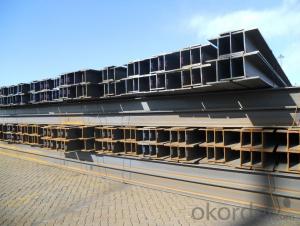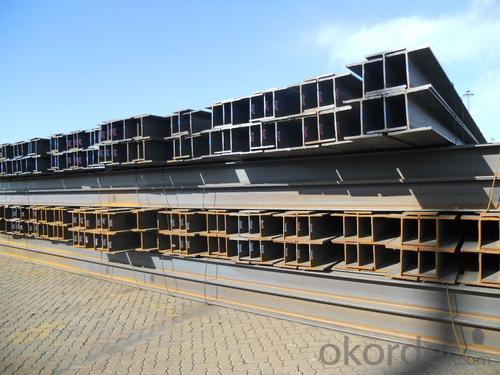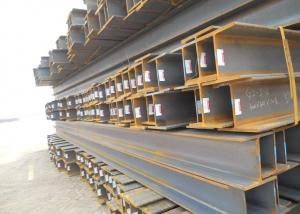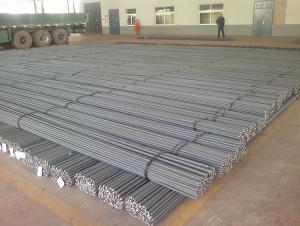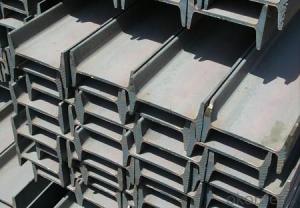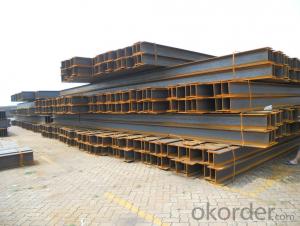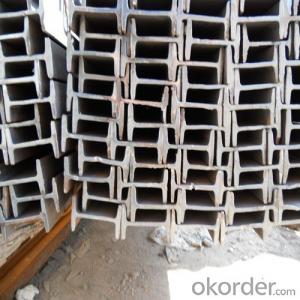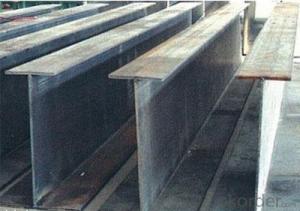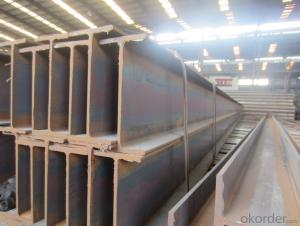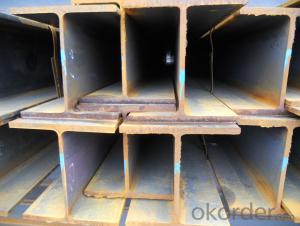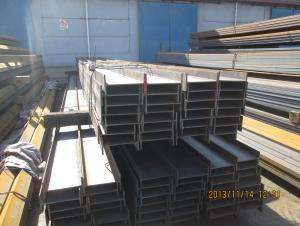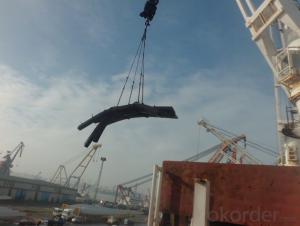Structual Carbon Steel Hot Rolled H-beam Bar
- Loading Port:
- China main port
- Payment Terms:
- TT or LC
- Min Order Qty:
- 25 m.t.
- Supply Capability:
- 1000 m.t./month
OKorder Service Pledge
OKorder Financial Service
You Might Also Like
Product Description:
OKorder is offering high quality Hot Rolled Steel I-Beams at great prices with worldwide shipping. Our supplier is a world-class manufacturer of steel, with our products utilized the world over. OKorder annually supplies products to European, North American and Asian markets. We provide quotations within 24 hours of receiving an inquiry and guarantee competitive prices.
Product Applications:
Commercial building structure ;Pre-engineered buildings; Machinery support structure; Prefabricated structure; Medium scale bridges; Ship-building structure.etc.
Product Advantages:
OKorder's Steel I-Beams are durable, strong, and resist corrosion.
Main Product Features:
· Premium quality
· Prompt delivery & seaworthy packing (30 days after receiving deposit)
· Corrosion resistance
· Can be recycled and reused
· Mill test certification
· Professional Service
· Competitive pricing
Product Specifications:
Manufacture: Hot rolled
Grade: Q195 – 235
Length: 6m – 12m, as per customer request
Packaging: Export packing, nude packing, bundled
H x B
(mm)
| T1 | T2 | JIS Weight
(kg/m)
| GB Weight
(kg/m)
|
100*100 | 6 | 8 | 16.9 | 17.2 |
125*125 | 6.5 | 9 | 23.6 | 23.8 |
150*75 | 5 | 7 | 14 | 14.3 |
148*100 | 6 | 9 | 20.7 | 21.4 |
150*150 | 7 | 10 | 31.1 | 31.9 |
175*90 | 5 | 8 | 18 | 18.2 |
175*175 | 7.5 | 11 | 40.4 | 40.4 |
198*99 | 4.5 | 7 | 17.8 | 18.5 |
200*100 | 5.5 | 8 | 20.9 | 21.7 |
194*150 | 6 | 9 | 29.9 | 31.2 |
200*200 | 8 | 12 | 49.9 | 50.5 |
248*124 | 5 | 8 | 25.1 | 25.8 |
250*125 | 6 | 9 | 29 | 29.7 |
244*175 | 7 | 11 | 43.6 | 44.1 |
250*250 | 9 | 14 | 71.8 | 72.4 |
298*149 | 5.5 | 8 | 32 | 32.6 |
298*201 | 9 | 14 | 65.4 | |
300*150 | 6.5 | 9 | 36.7 | 37.3 |
294*200 | 8 | 12 | 55.8 | 57.3 |
300*300 | 10 | 15 | 93 | 94.5 |
346*174 | 6 | 9 | 41.2 | 41.8 |
350*175 | 7 | 11 | 49.4 | 50 |
340*250 | 9 | 14 | 78.1 | 79.7 |
350*350 | 12 | 19 | 135 | 137 |
400*200 | 8 | 13 | 65.4 | 66 |
390*300 | 10 | 16 | 105 | 107 |
400*400 | 13 | 21 | 172 | 172 |
446*199 | 8 | 12 | 65.1 | 66.7 |
450*200 | 9 | 14 | 77.9 | 79.5 |
440*300 | 11 | 18 | 121 | 124 |
496*199 | 9 | 14 | 77.9 | 79.5 |
500*200 | 10 | 16 | 88.2 | 89.6 |
488*300 | 11 | 18 | 125 | 129 |
596*199 | 10 | 15 | 92.5 | 95.1 |
600*200 | 11 | 17 | 103.4 | 106 |
588*300 | 12 | 20 | 147 | 151 |
700*300 | 13 | 24 | 182 | 185 |
800*300 | 14 | 26 | 207 | 210 |
900*300 | 16 | 28 | 240.1 | 243 |
Payment:
-Invoicing on theoretical weight or actual weight as customer’s request.
-FOB, CFR or CIF.
-Regular terms of payment:
1, 30% payment in advance, the remaining balance (70% payment) against the copy of B/L. 100% payment before shipment.
2, 30% payment in advance, the remaining balance (70% L/C) against the copy of B/L. 100% payment before shipment.
3, Negotiable.
FAQ:
Q1: Why buy Materials & Equipment from OKorder.com?
A1: All products offered byOKorder.com are carefully selected from China's most reliable manufacturing enterprises. Through its ISO certifications, OKorder.com adheres to the highest standards and a commitment to supply chain safety and customer satisfaction.
Q2: What makes stainless steel stainless?
A2: Stainless steel must contain at least 10.5 % chromium. It is this element that reacts with the oxygen in the air to form a complex chrome-oxide surface layer that is invisible but strong enough to prevent further oxygen from "staining" (rusting) the surface. Higher levels of chromium and the addition of other alloying elements such as nickel and molybdenum enhance this surface layer and improve the corrosion resistance of the stainless material.
Q3: Can stainless steel rust?
A3: Stainless does not "rust" as you think of regular steel rusting with a red oxide on the surface that flakes off. If you see red rust it is probably due to some iron particles that have contaminated the surface of the stainless steel and it is these iron particles that are rusting. Look at the source of the rusting and see if you can remove it from the surface.
Images:
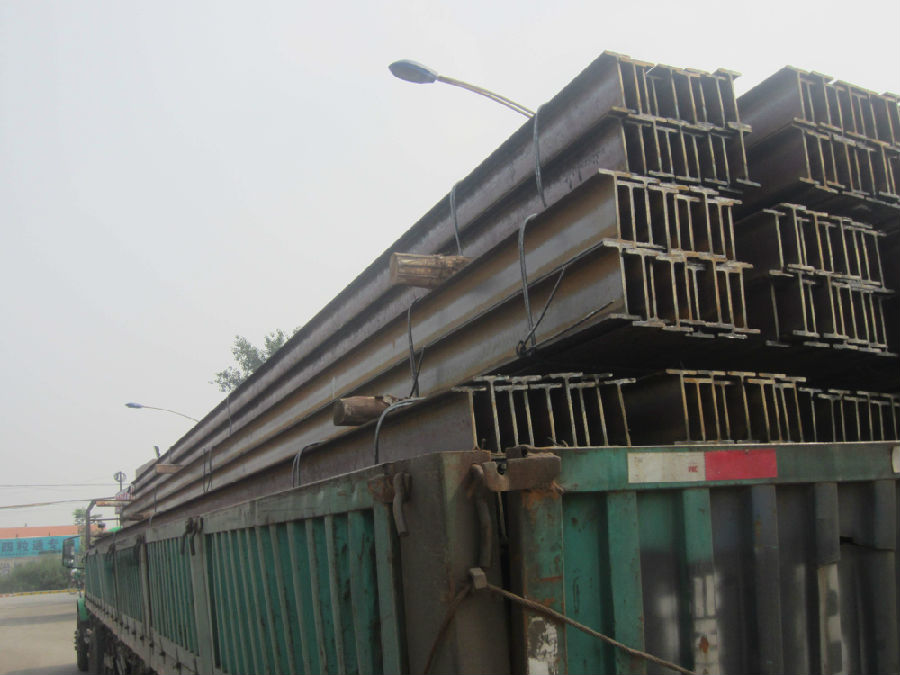
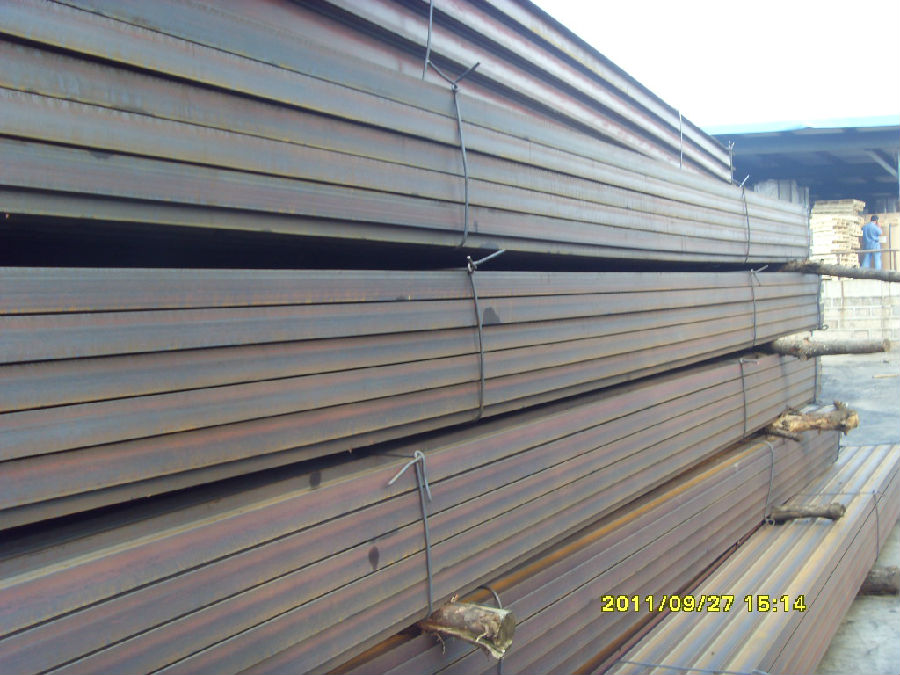
- Q: How do steel H-beams contribute to the overall ventilation and airflow in a building?
- Steel H-beams do not directly contribute to the overall ventilation and airflow in a building. H-beams are structural elements used in construction to support the weight of the building, distribute loads, and provide stability. They are typically used in the construction of the building's framework and are not directly involved in the ventilation system. However, a well-designed ventilation system can be integrated with the steel H-beams in a building to enhance airflow. The placement and arrangement of the H-beams can be taken into consideration during the design process to ensure that they do not obstruct the airflow. By strategically locating air intake and exhaust vents in the building, the ventilation system can efficiently circulate fresh air and remove stale air. Additionally, the layout of the H-beams can affect the distribution of air within the building. By considering the placement of the H-beams in relation to the ventilation system, it is possible to create air channels or ducts that help direct the flow of air to different areas of the building. In summary, while steel H-beams themselves do not directly contribute to ventilation and airflow in a building, their proper placement and integration with the ventilation system can help optimize airflow and ensure efficient ventilation throughout the building.
- Q: Can steel H-beams be used in the construction of theme resorts or hotels?
- Yes, steel H-beams can be used in the construction of theme resorts or hotels. Steel H-beams are commonly used in construction due to their strength, durability, and load-bearing capabilities. They provide structural support and stability, making them suitable for large-scale projects like theme resorts or hotels. Additionally, steel H-beams can be customized and easily assembled, allowing for flexibility in design and construction.
- Q: Can steel H-beams be used in mezzanine construction?
- Yes, steel H-beams can be used in mezzanine construction. Steel H-beams are commonly used for structural support in mezzanine floors due to their strong load-bearing capacity and durability. They provide excellent stability and can efficiently distribute the weight of the mezzanine structure, making them a suitable choice for such construction projects.
- Q: How do Steel H-Beams contribute to the overall daylighting or natural lighting of a structure?
- The main purpose of Steel H-Beams is to provide structural support and stability to a building, rather than directly contributing to its overall daylighting or natural lighting. These beams are commonly utilized in construction projects to bear heavy loads, such as the weight of floors, walls, and roofs. Daylighting or natural lighting in a building refers to the utilization of natural light to illuminate the interior spaces, reducing the need for artificial lighting during the daytime. To optimize the entry of natural light, various architectural elements and design strategies are employed, including the incorporation of large windows, skylights, light shelves, and light tubes. Although Steel H-Beams do not directly contribute to daylighting, they play an indirect role in supporting the architectural elements that facilitate natural lighting. By providing the necessary framework and structural integrity, these beams allow for the installation of large windows, skylights, and other elements that maximize the entry of natural light into the building. With their reliable support system, Steel H-Beams enable architects and engineers to design buildings with larger openings for windows and skylights, thereby allowing more natural light to penetrate the interior spaces. Therefore, while Steel H-Beams may not directly contribute to daylighting or natural lighting, they are crucial in creating a structural framework that supports the architectural elements responsible for maximizing the entry of natural light into a building.
- Q: What are the different design considerations when using steel H-beams in architectural projects?
- When using steel H-beams in architectural projects, there are several important design considerations to take into account. Firstly, the structural requirements of the project must be carefully assessed to determine the appropriate size and strength of the H-beams. This involves considering factors such as the loads the beams will need to support, the span they will cover, and any potential deflection limits. Another consideration is the aesthetic aspect of the design. Steel H-beams can be left exposed as a design feature in some architectural projects, so the appearance and finish of the beams should be considered. This may involve selecting a specific type of steel with desired aesthetics or exploring options for coatings or finishes. Fire resistance is also a crucial consideration. Steel H-beams can lose their strength in high temperatures, so fire protection measures need to be incorporated into the design. This may involve using fire-resistant coatings or incorporating fire-rated materials to protect the beams. Lastly, the fabrication and installation process should be considered. Steel H-beams are typically fabricated off-site and then transported to the construction site. Therefore, transportation and lifting requirements, as well as the ease of on-site assembly, must be taken into account during the design process. Overall, careful consideration of structural, aesthetic, fire resistance, and fabrication considerations is essential when using steel H-beams in architectural projects.
- Q: What are the requirements for steel H-beams in seismic zones?
- Steel H-beams in seismic zones need to meet specific requirements in order to ensure their structural stability and resistance to earthquakes. These requirements aim to minimize the risk of collapse or significant damage during seismic events. Some of the key requirements for steel H-beams in seismic zones are as follows: 1. Material Strength: H-beams should be made of steel with high tensile strength and excellent ductility to withstand the forces exerted during earthquakes. It is recommended to use high-strength low-alloy (HSLA) steel or structural steel with a minimum yield strength of 345 MPa (50 ksi). 2. Design Standards: H-beams in seismic zones must comply with specific design standards, such as the American Institute of Steel Construction (AISC) Seismic Provisions for Structural Steel Buildings or the Eurocode 8. These standards provide guidelines for the design, fabrication, and installation of H-beams to ensure their performance during seismic events. 3. Moment-Resisting Frames: H-beams in seismic zones are often part of moment-resisting frames (MRFs), which are designed to resist lateral forces caused by earthquakes. The design and connection of H-beams in an MRF should enable them to effectively absorb and distribute seismic forces. 4. Connection Details: The connection details between H-beams and other structural members, such as columns and beams, are crucial in seismic zones. Connections should be designed to ensure sufficient strength, stiffness, and ductility, allowing for the transfer of seismic forces without failure. 5. Damping Devices: In some cases, additional damping devices may be necessary to reduce the response of steel H-beams to seismic forces. These devices, such as viscous dampers or friction dampers, dissipate energy and minimize the deformation and displacement of H-beams during earthquakes. 6. Quality Control: Strict quality control measures should be implemented during the fabrication, welding, and installation of steel H-beams in seismic zones. This includes ensuring proper welding techniques, inspecting welds for defects, and conducting non-destructive testing to verify the quality and integrity of the H-beams. It's important to note that the specific requirements for steel H-beams in seismic zones may vary depending on local building codes, regulations, and the level of seismic hazard in the area. Therefore, it is crucial to consult with structural engineers and adhere to the applicable codes and standards when designing and constructing steel H-beams in seismic zones.
- Q: What are the common surface treatments available for steel H-beams?
- Some common surface treatments available for steel H-beams include hot-dip galvanizing, paint coatings, and powder coatings.
- Q: Can steel H-beams be used for supporting airport hangars?
- Yes, steel H-beams can be used for supporting airport hangars. Steel H-beams are commonly used in construction due to their high strength and durability. They provide excellent structural support and can withstand heavy loads, making them ideal for supporting large structures like airport hangars. The H shape of the beams allows for efficient distribution of weight, ensuring stability and preventing any structural failure. Moreover, steel H-beams can be easily fabricated and customized to meet the specific requirements of the hangar, such as size and weight capacity. Overall, steel H-beams are a reliable and cost-effective choice for supporting airport hangars.
- Q: How do steel H-beams perform in mining and industrial facilities?
- Steel H-beams perform exceptionally well in mining and industrial facilities due to their high strength and durability. These beams provide robust structural support, enabling them to withstand heavy loads, vibrations, and harsh conditions commonly found in these environments. Additionally, their versatility allows for easy customization and installation, making them a preferred choice for various applications such as supporting heavy machinery, constructing conveyor systems, and creating overhead cranes. Overall, steel H-beams are reliable and efficient in enhancing the safety and operational efficiency of mining and industrial facilities.
- Q: How do steel H-beams contribute to energy efficiency in buildings?
- Steel H-beams contribute to energy efficiency in buildings in several ways. Firstly, steel H-beams are known for their strength and durability. By using steel H-beams as structural elements in buildings, it allows for larger open spaces and larger window openings. This enables more natural light to enter the building, reducing the need for artificial lighting during the day. Natural light not only helps to reduce energy consumption, but also has positive effects on occupant well-being and productivity. Secondly, steel H-beams have excellent thermal properties. They have a high thermal mass, which means they can absorb and store heat energy efficiently. This helps to regulate indoor temperature by slowing down the rate at which heat transfers through the building envelope. As a result, the building requires less energy for heating and cooling, leading to reduced energy consumption and lower utility bills. Moreover, steel H-beams also play a significant role in the insulation of buildings. They provide a strong and stable framework for insulation materials, such as mineral wool or foam, to be installed. Proper insulation helps to prevent thermal bridging, which is the transfer of heat between the interior and exterior of a building through solid materials. By minimizing thermal bridging, steel H-beams help to enhance the overall thermal performance of the building, reducing the need for excessive heating or cooling. Additionally, steel H-beams are often used in the construction of green roofs and solar panel systems. Green roofs help to insulate the building, reduce stormwater runoff, and improve air quality. Solar panels, on the other hand, harness renewable energy from the sun and convert it into electricity. Steel H-beams provide the necessary support and structural integrity for these sustainable features, contributing to the overall energy efficiency of the building. In conclusion, steel H-beams contribute to energy efficiency in buildings by allowing for more natural light, providing excellent thermal properties, enabling proper insulation, and supporting sustainable features like green roofs and solar panels. Their strength, durability, and versatility make them an essential component in constructing energy-efficient buildings.
Send your message to us
Structual Carbon Steel Hot Rolled H-beam Bar
- Loading Port:
- China main port
- Payment Terms:
- TT or LC
- Min Order Qty:
- 25 m.t.
- Supply Capability:
- 1000 m.t./month
OKorder Service Pledge
OKorder Financial Service
Similar products
Hot products
Hot Searches
Related keywords
